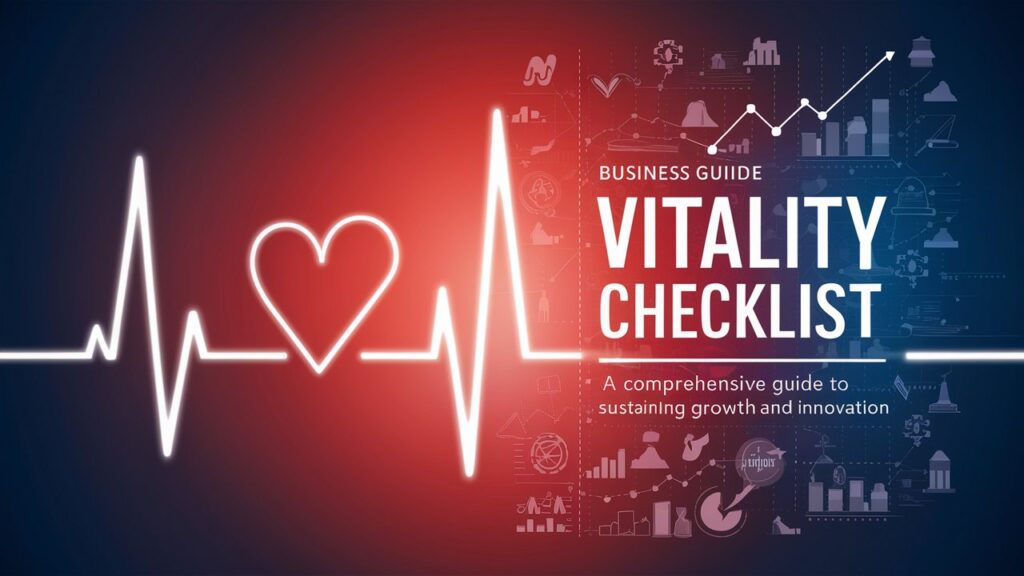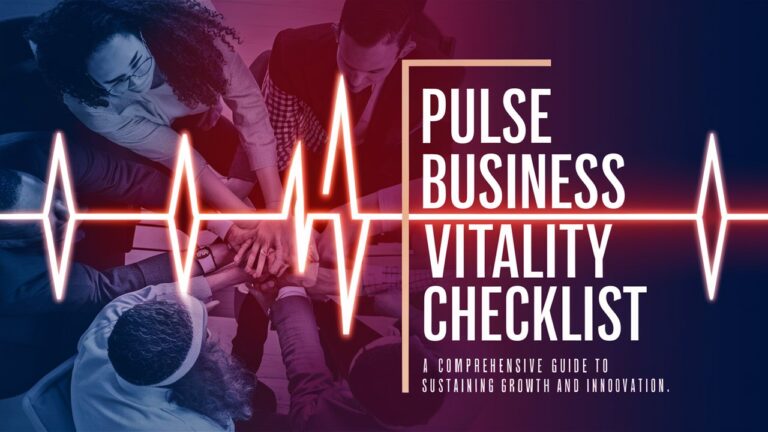Introduction
In today’s hypercompetitive business landscape, maintaining vitality is not just about survival—it’s about thriving. The Pulse Business Vitality Checklist serves as a strategic roadmap to assess, refine, and amplify your organization’s core strengths while addressing vulnerabilities. This checklist dives into critical areas like financial health, operational efficiency, market relevance, and innovation, offering actionable insights to fuel sustainable growth. Whether you’re a startup or an established enterprise, this guide will help you diagnose gaps, prioritize initiatives, and future-proof your business. Let’s explore the pillars that define business vitality and how to integrate them into your strategy.
1. Financial Health: The Backbone of Business Vitality
Keywords: Revenue Growth, Profit Margins, Cash Flow Management, Debt-to-Equity Ratio
A business’s financial health is the cornerstone of its vitality. Start by analyzing revenue growth trends: Are sales increasing YoY, or is stagnation setting in? Consistent growth signals market demand, while decline may indicate competitive threats or operational inefficiencies. Next, scrutinize profit margins—gross, operating, and net. Shrinking margins often reflect rising costs or pricing pressures. Implement cost-control measures or renegotiate supplier contracts to stabilize profitability.
Cash flow management is equally critical. Even profitable businesses can falter if cash reserves dwindle. Forecast cash inflows and outflows meticulously, and maintain a contingency fund for emergencies. Finally, evaluate your debt-to-equity ratio. Excessive debt can cripple flexibility, while too little may limit growth opportunities. Aim for a balanced structure that aligns with your risk appetite and expansion goals.
2. Operational Efficiency: Streamlining for Success
Keywords: Process Optimization, Technology Integration, Supply Chain Resilience
Operational efficiency ensures resources are used effectively to deliver value. Begin with process optimization: Map workflows to identify redundancies, bottlenecks, or manual tasks that slow productivity. Lean methodologies like Six Sigma or Kaizen can eliminate waste and enhance output.
Invest in technology integration to automate repetitive tasks. Tools like ERP systems, AI-driven analytics, or cloud-based collaboration platforms reduce human error and accelerate decision-making. For example, automating inventory management can prevent stockouts and overstocking.
Strengthen supply chain resilience by diversifying suppliers and adopting real-time tracking systems. The pandemic underscored the risks of over-reliance on single sources—build flexibility to mitigate disruptions.
3. Market Relevance: Staying Ahead of the Curve
Keywords: Customer Insights, Competitive Analysis, Brand Positioning
Market relevance hinges on understanding evolving customer needs and outperforming competitors. Conduct regular customer insights surveys, focus groups, or social listening to gauge sentiment. Use this data to refine products, services, or user experiences.
Competitive analysis is equally vital. Benchmark your offerings against industry rivals. Identify gaps in pricing, features, or customer service, and craft strategies to differentiate your brand. Tools like SWOT analysis or Porter’s Five Forces provide structured frameworks for evaluation.
Finally, sharpen brand positioning. Clearly articulate your unique value proposition (UVP) through targeted messaging. For instance, if sustainability is a USP, highlight eco-friendly practices in marketing campaigns to resonate with conscious consumers.
4. Employee Engagement: Fueling Innovation from Within
Keywords: Talent Development, Workplace Culture, Employee Retention
Engaged employees drive innovation and productivity. Prioritize talent development through continuous learning programs, certifications, or mentorship opportunities. Upskilling teams in emerging technologies like AI or data analytics future-proofs your workforce.
Cultivate a positive workplace culture by fostering inclusivity, transparency, and recognition. Regular feedback loops, wellness programs, and flexible work arrangements boost morale. For example, remote work options can reduce burnout and attract top talent.
Employee retention strategies are equally crucial. High turnover disrupts operations and inflates recruitment costs. Offer competitive compensation, career progression paths, and meaningful work to retain high performers.
5. Customer Satisfaction: Building Loyalty and Advocacy
Keywords: Feedback Loops, Service Quality, Loyalty Programs
Customer satisfaction directly impacts retention and lifetime value. Implement feedback loops through post-purchase surveys, Net Promoter Score (NPS) assessments, or chatbot interactions. Act on insights promptly—for instance, resolving complaints within 24 hours can turn detractors into promoters.
Elevate service quality by training frontline teams in empathy and problem-solving. Consistent, personalized interactions build trust. A study by PwC found 73% of consumers rank customer experience as a key factor in purchasing decisions.
Launch loyalty programs to reward repeat customers. Tiered rewards, exclusive discounts, or VIP access to events deepen emotional connections and encourage advocacy.

6. Innovation and Adaptability: Embracing Change
Keywords: R&D Investment, Agile Practices, Digital Transformation
Innovation is the lifeblood of long-term vitality. Allocate resources to R&D investment to explore new products, services, or business models. For example, a restaurant might experiment with ghost kitchens or plant-based menus to tap into trends.
Adopt agile practices to accelerate prototyping and iteration. Cross-functional teams, sprint cycles, and rapid testing reduce time-to-market. Spotify’s “squad” model exemplifies agility, enabling continuous product updates.
Prioritize digital transformation to stay competitive. Migrate legacy systems to cloud platforms, leverage AI for predictive analytics, or explore blockchain for secure transactions.
7. Risk Management: Safeguarding Against Uncertainty
Keywords: Risk Assessment, Contingency Planning, Compliance
Proactive risk management mitigates threats to business continuity. Conduct a risk assessment to identify vulnerabilities—cyberattacks, regulatory changes, or economic downturns. Use risk matrices to prioritize high-impact, high-probability scenarios.
Develop contingency plans for crises. For instance, a cybersecurity breach response plan should include data backups, communication protocols, and legal consultations.
Ensure compliance with industry regulations (e.g., GDPR, OSHA) to avoid fines or reputational damage. Regular audits and employee training uphold standards.
8. Sustainability: Balancing Profit and Purpose
Keywords: Environmental Initiatives, Social Responsibility, Sustainable Supply Chains
Modern consumers and investors prioritize ethical practices. Launch environmental initiatives like carbon footprint reduction, waste recycling, or renewable energy adoption. Patagonia’s commitment to eco-friendly materials has bolstered its brand loyalty.
Demonstrate social responsibility through community partnerships, diversity programs, or charitable giving. TOMS Shoes’ “One for One” model integrates philanthropy into its core business.
Build sustainable supply chains by sourcing ethically produced materials. Transparent reporting through ESG frameworks enhances credibility.
Conclusion
The Pulse Business Vitality Checklist is more than a diagnostic tool—it’s a catalyst for transformation. By regularly evaluating financial stability, operational agility, market positioning, and innovation capacity, businesses can adapt to disruptions and seize emerging opportunities. Remember, vitality isn’t a one-time achievement; it’s a continuous journey of improvement. Use this checklist to stay proactive, resilient, and aligned with your long-term vision.
Frequently Asked Questions (FAQs)
Q1: How often should I use the Pulse Business Vitality Checklist?
Aim for quarterly assessments to track progress and adjust strategies. During crises or rapid growth, monthly reviews may be necessary.
Q2: What if my business struggles with multiple checklist areas?
Prioritize based on urgency and impact. For example, address cash flow crises before rebranding initiatives.
Q3: How do I measure customer satisfaction effectively?
Combine quantitative metrics (NPS, CSAT) with qualitative feedback (surveys, social media sentiment) for a holistic view.
Q4: Can small businesses benefit from this checklist?
Absolutely! The principles scale to any size. Focus on high-impact, low-cost actions like process automation or loyalty programs.
Q5: How do I balance sustainability with cost constraints?
Start with incremental changes, like reducing energy consumption or partnering with local suppliers. Many sustainable practices yield long-term savings.
By integrating the Pulse Business Vitality Checklist into your strategy, you’ll not only survive market shifts but emerge as a leader in your industry.
